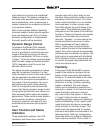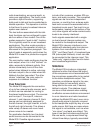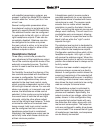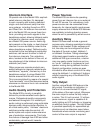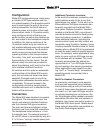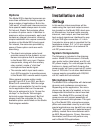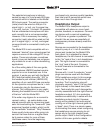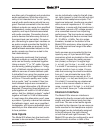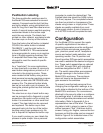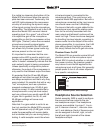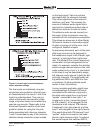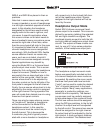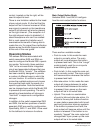
Model 233 User Guide Issue 1, September 2007
Studio Technologies, Inc. Page 15
are often part of broadcast and production
audio applications. While the output cir-
cuitry is not intended to be “on-air” quality,
overall audio performance should be very
good. Devices connected to the line-level
talkback outputs can range from amplified
loudspeakers, analog inputs on intercom
systems, and input channels associated
with audio consoles. Connecting the out-
puts to devices that allow easy control of
the signal level can be helpful. For exam-
ple, connecting to spare input modules on
an audio console provides the flexibility to
add gain or attenuate as required. Dedi-
cated talkback-associated outputs on the
audio console can then be routed to the
final destination(s).
As previously mentioned, the line-level
talkback outputs on multiple Model 233
units can be directly connected together.
Using a simple “Y” or “W” cable, this pas-
sive summing (adding together or “bridg-
ing”) of talkback signals allows one audio
cable to serve as a master talkback path.
A side effect from using this passive sum-
ming technique is that signal attenuation
will occur. The audio quality won’t suffer,
but an audio “pad” is created. If two line-
level talkback outputs are connected to-
gether, a signal attenuation of 6 dB can be
expected. Connecting three talkback out-
puts together will result in 9.5 dB of atten-
uation. And four talkback outputs “multed”
together will lead to 12 dB of attenuation.
In most cases this attenuation won’t pose
a problem. Typically a device that receives
the talkback signal, such as an amplified
loudspeaker, will have an adjustable input
sensitivity so this attenuation won’t prove
to be a problem.
Line Inputs
The Model 233 allows two line-level audio
sources to be connected. These sources
can be individually routed to the left chan-
nel, right channel, or both the left and right
channel of the headphone outputs. The
inputs are balanced, transformer-coupled
with a nominal impedance of 10 k ohms.
Capacitors, in series with the transformer’s
input leads, prevent a DC voltage present
on a connected source from impacting
performance. The line inputs are compat-
ible with signals that have a nominal level
of –12 dBV to +6 dBu. Two trim poten-
tiometers, located on the bottom of the
Model 233’s enclosure, allow signals over
this wide nominal level range to be effec-
tively utilized.
Audio sources are connected to the line
inputs by way of 3-pin female XLR-type
connectors which are located on the unit’s
back panel. Prepare the mating connec-
tors (males) so that pin 2 is signal high
(+ or hot), pin 3 is low (– or cold), and pin
1 is shield. If connecting a source in this
manner results in hum or noise, it’s pos-
sible that removing the shield connection
from pin 1 can eliminate the issue. With
an unbalanced source connect pin 2 to
signal high (+ or hot) and both pins 1 and
3 to shield. If connecting an unbalanced
source in this manner results in hum or
noise, connect pin 2 to high (+ or hot) and
pin 3 to shield; leave pin 1 unterminated.
Intercom Interface
The Model 233’s intercom interface is
designed to directly connect with standard
single- and dual-channel party-line inter-
com lines. The one or two audio signals
provided by the intercom line can serve as
audio sources for the headphone outputs.
Each signal can be individually assigned
to the left channel, the right channel,
or both the left and right channels. The
Model 233 can also be configured to send
talkback audio to either or both of the



